Training, development and retaining the best employees is a critical business strategy. Moreover, because of the limited distribution of exceptional talent amongst society in general, we are faced with the necessity of achieving extraordinary results from ordinary people. It is not ethical and not legally possible simply to fire people whose job skills are inadequate.
It is also not fair to promote people into higher positions without giving them guidance and assistance. We therefore need an effective and reliable process, comprising specific activities and skills, to involve and develop our staff. It is called coaching.
Coaching is a developmental process. It helps people to “grow” – if it is conducted by means of facilitated discovery and hands-on experience. Delivering an oration about a performance problem is completely ineffective. Telling is not coaching.
On-The-Job Coaching Process
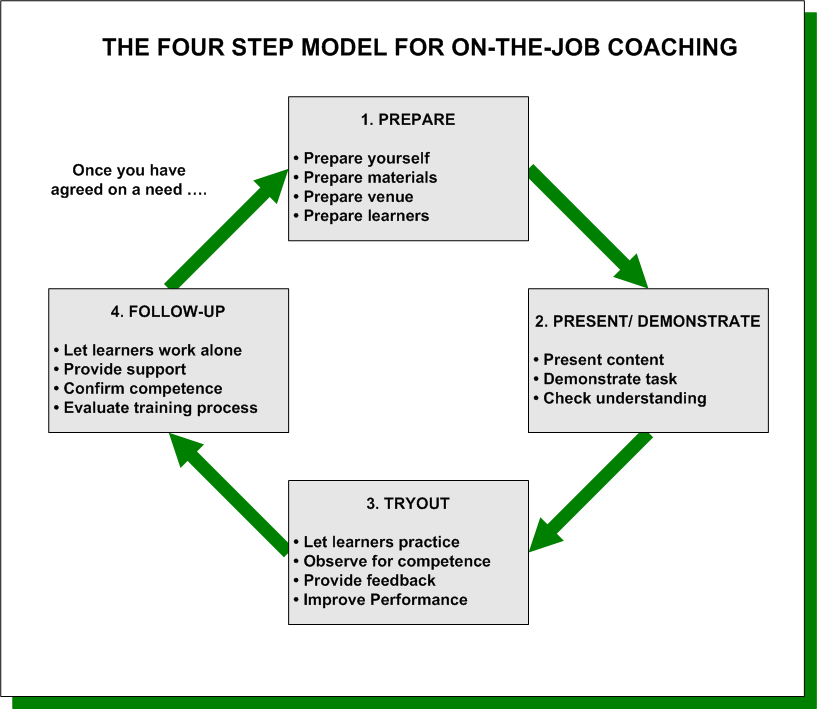
Preparation to Coach

It is important that you know how adults learn best. There are many different forms of learning challenges that you will need to be aware of and be able to deal with when coaching.
To be able to identify coach’s difficulties and needs you must be familiar with the principles of adult learning.
How do adults learn?
- Adults learn for a reason (why).
- Adults learn by putting skills into practice or by transferring knowledge, e.g. teaching it to someone else.
- Adults learn when learning is beneficial/adds value.
- Adults learn from their own point of reference or experience.
- Adults learn in a logical way, e.g. step-by-step.
- Adults learn differently depending on their abilities, experience and background.
- Adults want feedback all the time.
- The adult is a partner in the learning process.
- Adults are capable of taking responsibility for their own learning.
- Adult learners gain through reflection on their own and others’ experience.
- Adults learn what they perceive to be useful in their life situations.
- Adults’ attention spans are a function of their interest in the experience.
- Adults are most receptive to instruction that is clearly related to problems they face daily.
- Adults learn best when they are treated with respect.
- Adults learn better in a climate that is informal and personal.
- Adults learn when they feel supported in experimenting with new ideas and skills.
- Adults are likely to have somewhat fixed points of view that make them closed to new ways of thinking and behaving.
In order to train/coach effectively you need to be sure of the following:
- Who do you need to coach?
- What is the desired level of knowledge/skill that would mean that the learner has achieved competence? (What do they need to know that they currently don’t know?)
- What is their current level of knowledge/skill? (What don’t they know how to do?)
- What is the best way of closing the gap between b and c?
We call this the “competence gap”. It can be portrayed as follows:
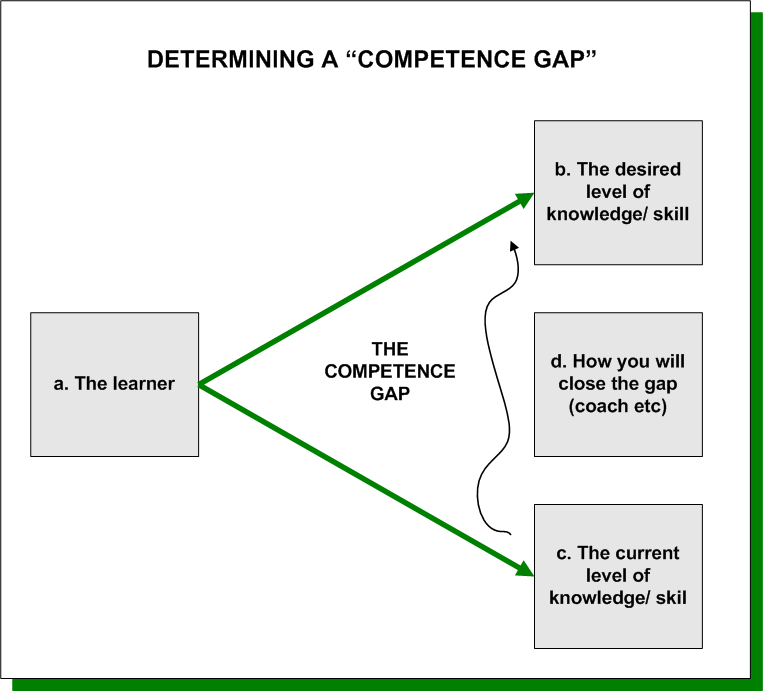
Building A Coaching Plan

Consider the following questions relating to the competence gap above. It will help you prepare for coaching.
Click here to download an example of preparation for coaching checklist.
Preparing the Coaching Materials and Venue
- Ensure that if you are coaching a technical skill, you have the required equipment on which the learner will practice and demonstrate their competence.
- Ensure that there is adequate space and that the venue is clean.
- Set up whatever equipment is needed.
- Provide privacy for the coaching session and ensure that there will no be interruptions by booking the venue early.
- Ensure that the learners are comfortable and not subject to any undue stress.
- The location of coaching venue is of major importance to both the coach and the learner. For learning to take place effectively we need to create a comfortable and appropriate learning environment.
|
Planning of Coaching Venue Checklist |
||
|
1 |
The number of participants |
|
|
2 |
The size of the room |
|
|
3 |
The arrangement/layout of the room |
|
|
4 |
Availability of suitable chairs |
|
|
5 |
The arrangement of tables and chairs |
|
|
6 |
Adequate lighting |
|
|
7 |
Noise |
|
|
8 |
Temperature |
|
|
9 |
Access |
|
|
10 |
Facilities |
|
|
11 |
Identify possible distractions |
|
|
12 |
Acoustic qualities of venue |
|
|
13 |
Sufficient power outlets |
|
|
14 |
Training aids |
|
|
15 |
Spaces |
|
|
16 |
Storage areas |
|
|
17 |
Fire equipment |
|
|
18 |
Safety assembly points |
|
Preparing the Learners
- Ensure that you have identified a real learning need which the learner would benefit from addressing.
- Ensure that the learner agrees that it is a genuine need.
- Make sure the learner is aware of any relevant standards which relate to the topic.
- Discuss the learning need in order to determine the learner’s current level of competence.
- Use observations of the learner’s performance to guide your understanding
- Agree on a time and venue for the coaching
- Provide the learner with timeous information about the process and any assessment criteria.
Presentation/Demonstration
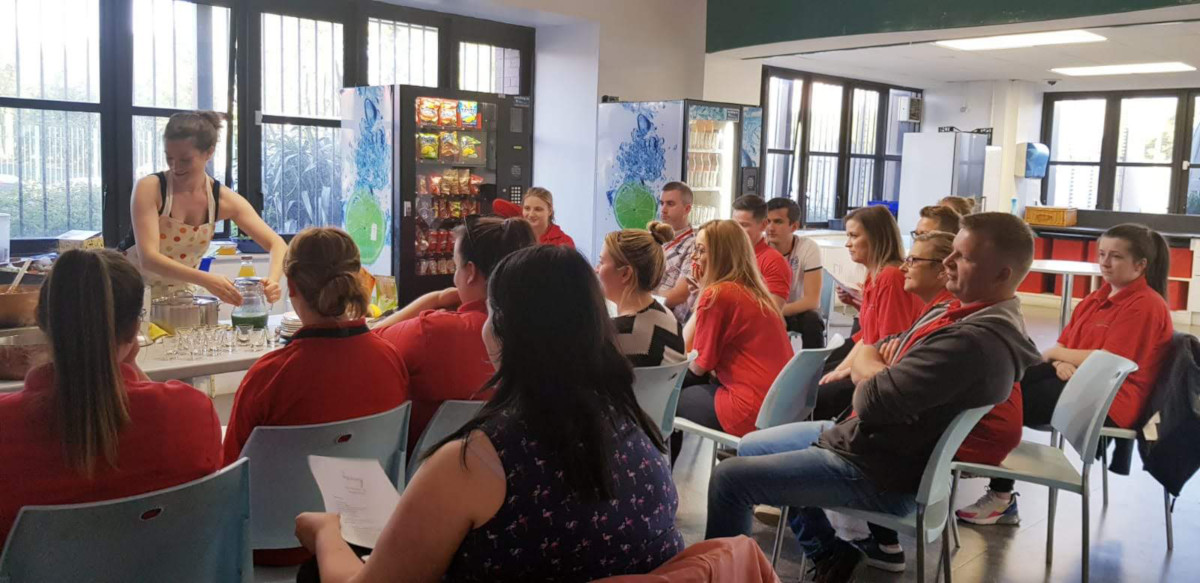
The second step of the four-step Coaching Method is Presentation/Demonstration.
During this step you will:
- Present the coaching content.
- Demonstrate the task.
- Verify that the learners understand the task.
Present the Coaching Content
Keep in mind that the key points of your presentation and demonstration are based on the learning objectives of the coaching outline. Begin by telling the learners the learning objectives for the session. If they know where you are leading them, they are likely to follow.
There are several techniques you can follow that will make your presentation more effective.
Follow a logical sequence. Explain the procedure in a step-by-step manner. Begin with the first thing to be done, followed by the second step, and so on.
Be clear and concise. Get to the point and eliminate anything that’s necessary. The less you say, the less the learners will have to remember.
Explain the reasons “why”. Give an explanation of why it is best to perform the task a certain way. This will keep learners from developing bad habits.
Stress key points. Provide the key points to ensure that the trainee is focused on learning the job.
Avoid jargon and buzz words. Keep your presentation simple and to the point. Too many terms will confuse the trainee.
Speak at a moderate speed. Avoid speaking too slowly – you may offend the trainee. On the other hand, if you speak too quickly, the trainee may not be able to comprehend an idea before you move on to the next one.
Make frequent eye contact. Look at your learners frequently during the presentation. Maintain eye contact for approximately three to five seconds before you look away. The expressions in the learners’ eyes will offer clues as to how well they are understanding what you are saying.
Be enthusiastic. Demonstrate your interest in the topic. If the learners appear bored, they may be reflecting back the message you are sending them. Enthusiasm is contagious, and the participants will catch it.
Demonstrate the Task
Researchers estimate that people remember only 20% of what they hear but up to 50% of what they see and hear. So, it makes sense that you should demonstrate the task.
Here are several techniques that will make your demonstration more effective:
Position the employee correctly. The trainee must be able to see the entire demonstration. If possible, avoid having the trainee directly opposite you, as this creates a mirror image, and the trainee has to sort out what is done with right and left hands. The best position is beside. Depending on the angle and the space available, you may have to step back occasionally or exaggerate your movements while performing the task.
Use manageable sections. Demonstrate the task one step at a time. If possible, have the demonstration follow the sequence of your presentation. Presenting the whole task at one time will cause confusion and will overload the trainee with too much information.
Demonstrate first at the expected work speed. The first time you demonstrate the task, do it at the required speed. This will establish the standards for speed and accuracy. Do not try to impress the trainee by doing the task faster. Explain that you don’t expect the trainee to achieve this same speed and accuracy immediately.
Demonstrate next at a slower speed. Although you may have done the job one hundred times, it’s the first time for the trainee. A slower speed will enable the trainee to learn the task and grasp the details.
Use real materials, props or cut-away. Whenever possible, use real materials during the demonstration. If this is not possible, obtain or develop a prop. Request that your company provide samples, props or cut-away for the coaching. The more realistic the demonstration, the easier it is for the trainee to complete the tryout step.
Check That Learners Understand the Task
Even if you present and demonstrate a task the same way every time you train, it is unlikely that all learners will respond in the same manner. Some will learn quicker than others, some will have more questions, and some,
In spite of your best efforts, may never quite understand the task. Always verify the trainee understands of the task before you move to the tryout step in the coaching process.
There are three ways you can test a trainee’s understanding:
Ask for Questions
At points throughout the coaching, ask learners, “What questions do you have?” With this request, you are indicating that questions are part of the coaching process.

Have Learners Repeat Instructions
Focus on relevant points that must be followed to perform the task properly. Don’t ask them to repeat the entire process. Tell them that you are asking them to repeat instructions because you are concerned about how well you communicated the message.
Test Verbally for Understanding
Keep the questions short and to the point. Your goal is to verify understanding while reinforcing what the learners are learning. Usually, you’ll need only two or three questions to determine what the learners have learned. This allows the learners to develop the confidence that they are making progress and that they are learning the task.
Try to avoid questions that can be answered with a simple “Yes” or “No”, as these answers give very little insight into what the learners have learned.
Ask open-ended questions that begin with words such as what, why, how, when or where. For example, “Where would you store the oily rags after cleaning the equipment?”
Tryout
The third of the four-step Coaching Method is Tryout. During this step, you will:
- Implement the learners’ practice.
- Observe the learners’ practice.
- Provide feedback to the learners.
- Help the learners gain speed and develop accuracy.
Implement the Learner’s Practice
A tryout should follow the presentation and demonstration as soon as it is practical. The less time that passes between the presentation/demonstration step and practice, the easier it will be for the learners to perform the task correctly. The learners also will require less review.
To make the practice time beneficial: Have the learners explained the task?
Their explanation will help you determine whether they understand what you’ve taught. If every learner makes the same mistake, you’ll want to assess the points at which the presentation and demonstration were not clear.

Verbalising the task while they are performing it also reinforces the learners’ understanding. In a sense, they are “programming” their minds to recall the correct procedures. If their explanations are incomplete, correct them, so they aren’t “programmed” the wrong way.
Ask the Learners to Repeat the Practice to Create Habits
It has been said that “practice makes perfect”. Well, it does, provided it is a perfect practice. Some learners are able to practice the task correctly the first time, while others will have difficulty. Multiple practices are important because they create habits.
The number of times a task needs to be practiced will vary from learner to learner. The coach can move on to another task after the leaner consecutively performs the task correctly two or three times.
Observe the Learners’ Practice
Watch the learners as they practice and note any areas which need to be clarified or corrected. The goal of practice is to give the learners the opportunity to practice the task in a controlled environment while someone is available to help.
There are three ways to make the observation process easier:
Assess How you Observe
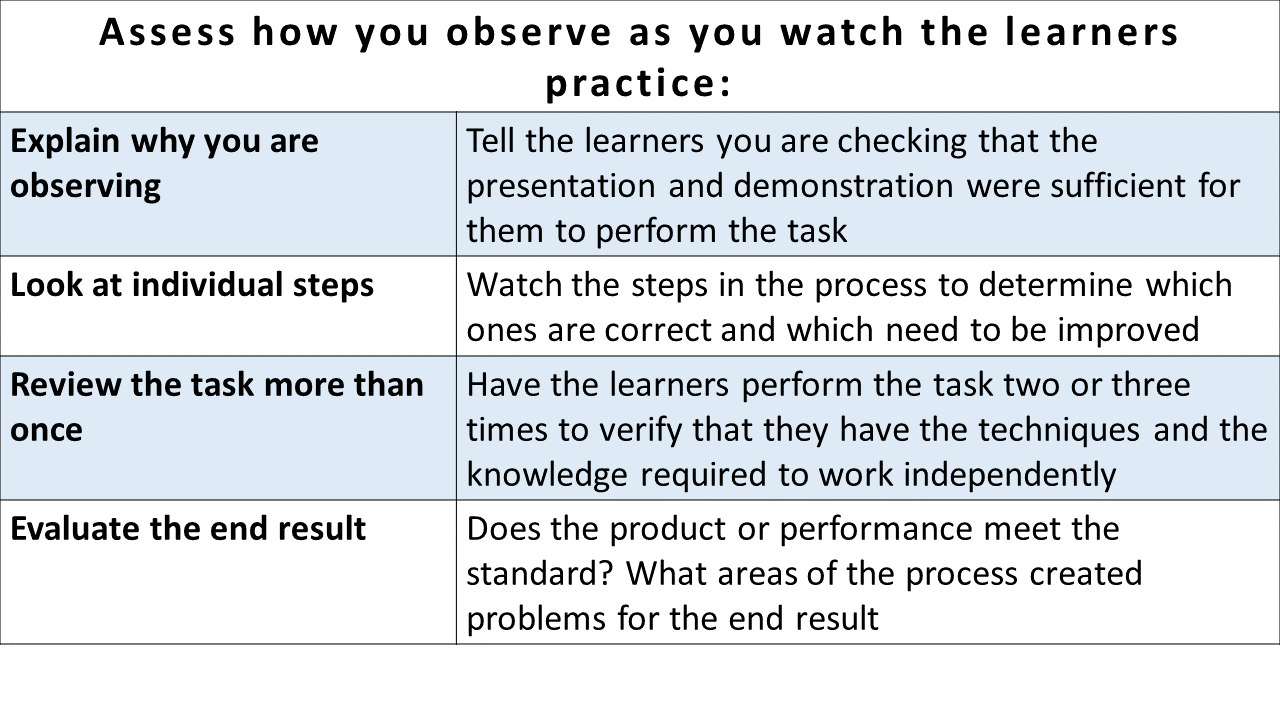
Recognise your influence on the learners
Learners are often nervous just because they are learning something new. With a coach watching, they can feel pressured during practice. Learners need to be assured that the coach is not being critical of their mistakes. You can say, “If someone were watching me, it would make me nervous. Don’t worry about making a mistake.”
Give the learners breathing room
If you are working with small groups and you have some learners who are learning quicker than others, have those who learn the task first assist the others who still need help. This approach allows learners to work with their peers, who are less intimidating than a coach. Allowing learners to work with less direct observation from the coach also can build their confidence because they will feel that you are beginning to trust their abilities.
Provide Feedback to Learners

Everyone wants feedback about how they perform. Learners need even more because they are learning something new. Giving feedback to learners during the tryout is very important. If you don’t give this feedback, the learners will assume they are right. Don’t let them make assumptions, especially if they’re wrong. Offer lots of feedback in the beginning, then taper off gradually. It’s better to err on the side of giving too much feedback than not giving enough.
When you give feedback to employees, be sure that your feedback is:
Specific – Tell the trainee exactly what you saw. Avoid vague and general statements.
Immediate – Give feedback as soon as you see the learners perform the task correctly or incorrectly. Don’t wait for them to do it again.
Earned – Avoid feedback that isn’t deserved just to make the learners feel good. Dishonest feedback is worse than no feedback at all.
Individualised – Give feedback to each person, not just to the group as a whole. Using the learners’ names also individualise it.
Positive – Remember that feedback always should be positive, even when telling learners they are practicing the task incorrectly.
Here are some ways to offer positive feedback:
Recognise successes. Acknowledging successes provides reinforcement and lets employees know you are encouraged by what they are learning.
Correct mistakes in a supportive manner. Most learners will make errors in the beginning. If they knew how to perform the task, they wouldn’t need the coaching! Sometimes learners become so concerned about their errors that they make the same mistake over and over. Correct mistakes in a supportive manner by focusing on the task being performed, not on the person performing it.
Click here to view a video that explains the giving and receiving of feedback.
Step-in When Necessary
There may be times during the tryout when you will have to step in and help the learners. For example:
- They are making an error that would cause a major problem with equipment.
- They are performing the procedure incorrectly, and it will affect what they do next.
- They are in danger of causing physical harm to themselves or others around them.
Mistakes that are not harmful may teach the learners an important lesson. Just be certain that the lesson is not detrimental to the person or the process.
Help Learners Gain Speed and Develop Accuracy
The first-time learners see you demonstrate a task at full speed; it may be a blur to them. You make it look easy because you’ve done it before. Learners are likely to be apprehensive about their ability to learn the task quickly. So, put your efforts into helping them gain speed and develop accuracy. To do this you should:
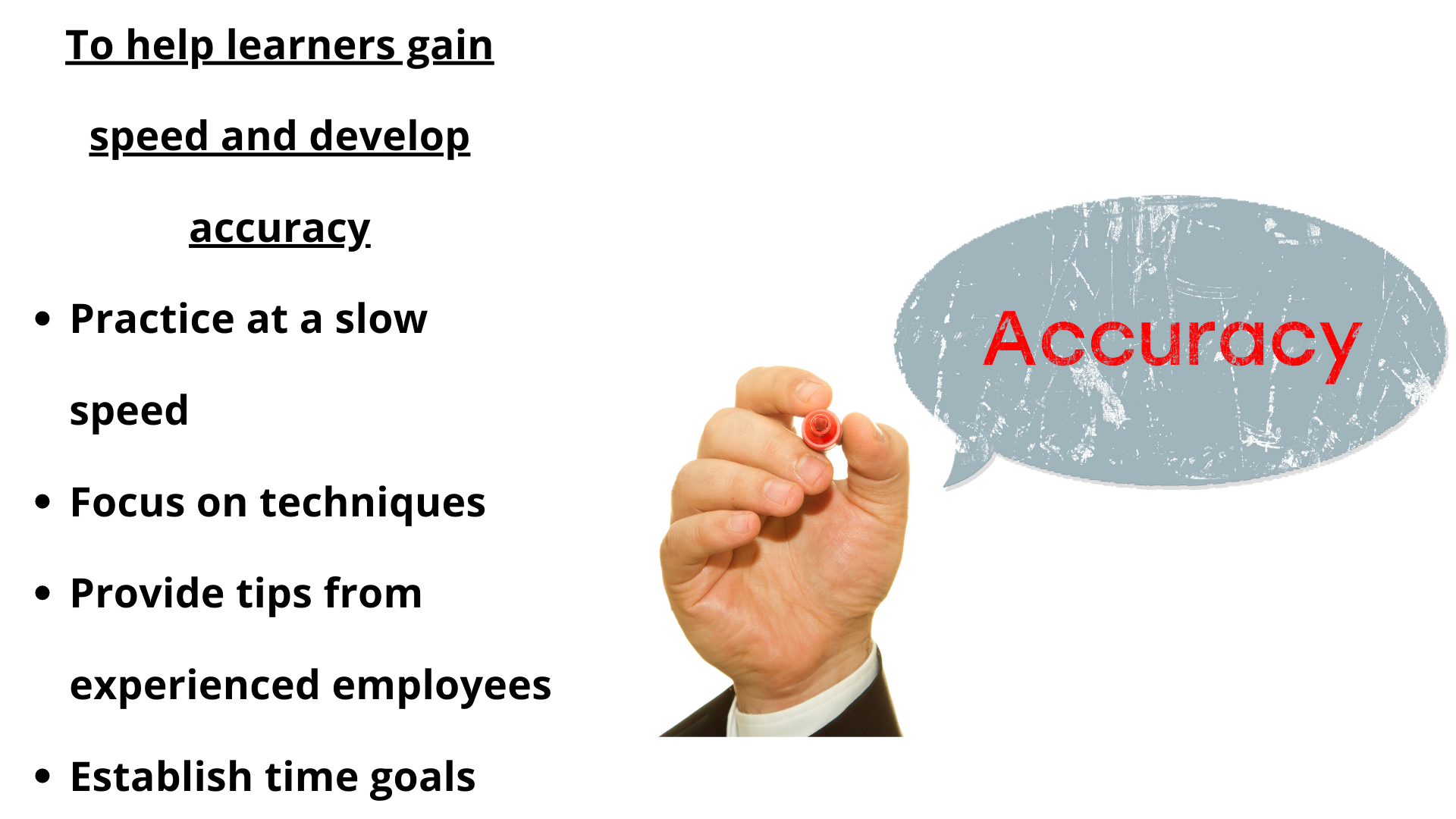
Practice at a slow speed. Allow learners to work at their own pace at first. Have them increase their speed gradually until they can meet the time requirements for the job.
Focus on techniques. When learners learn the proper techniques, they will develop speed as they continue to practice. It will be impossible for them to develop speed and gain accuracy until they sharpen the little things that are a part of the bigger job.
Provide tips from experienced employees. Nearly every experienced employee has “tricks of the trade”. Unless this is a new task that no one in the company has performed, share these tips with the learners at the appropriate time in the coaching process. Some tips, if given too early, may confuse the learners. Others, if given too late, will not be beneficial.
Establish time goals. Learners will develop speed sooner if they are given a deadline. Work with them to establish time goals for gaining speed and developing accuracy. Tell them when they should begin increasing their speed and monitor their progress on a regular basis. Provide positive feedback as they come closer to reaching the goal.
Follow-Up
The fourth of the four-step Coaching Method is Follow-Up. During this step you will:
- Have the learners work alone?
- Designate “helpers” for the learners.
- Reconfirm that the learners understand the task.
- Evaluate the coaching procedures.
Follow-up may occur in conjunction with the tryout. In many cases, though, the learners will work alone, without observation, after the tryout has been completed, and the trainee will conduct the follow-up later. When follow-up occurs later, it should be a two-way process in which the learners contract the coach for help, as needed, and the coach checks to see how they are doing.
Have Learners Work Alone

One of the best ways to build confidence in learners is to tell them that you believe they are capable of working alone. Before you turn them loose, however, it’s a good idea to review the tasks with them once again. Have them explain the key points and show you the correct way to perform the tasks. This also is a good opportunity to provide additional positive feedback, encourage them to continue to do the job right, and remind them about avoiding bad habits.
Don’t back away completely from your learners. The whole idea of follow-up is checking back after the learners have been working alone for a while to see how they are doing. Check often at first, as this is the time when questions and problems will likely occur.
The follow-up covers many of the same activities as the tryout. When you check back, make it a point to observe employees performing the task and look for errors. Be prepared to provide feedback during the observation. Recognise successes when employees perform correctly. But don’t ignore mistakes. If you find problems, correct mistakes in a supportive manner. Step in, when necessary, and provide assistance or re-coaching.
Gradually reduce the frequency of your contacts with them. There are no hard-and-fast guidelines for when the process should be stopped. Each trainee is different. Some may require only one or two follow-up sessions, while others may need several sessions.
Designate “Helpers” For Learners
Before ending the follow-up, find “helpers” for the learners. The learners need someone who will be available to answer questions or solve problems. You may designate yourself, or you may decide to find another person.

Benefits of Designating Yourself
- In most cases, you are the best person for the learners to contact, since you have established a relationship with them.
- You know their strengths and weaknesses.
- You may take a more personal interest in the learners.
- You are a “neutral” person who will provide answers to their training-related problems, assuming that you are not the learners’ supervisor.
- You understand the task that the learners are trying to incorporate into their jobs and will be able to provide them with solutions.
Benefits of Designating Others
- There are situations when another person would be a better helper.
- You may not be available to help the learners because you are coaching other employees or have demands on your time.
- Learners may be reluctant to admit to you that they are experiencing problems.
- Learners may prefer to go to their supervisor or another person in their work area.
What to Consider When Delegating Others
If you decide to ask other people to assist the learners as on-the-job helpers, be sure of the following:
- They have a good relationship with the person, especially if the helper is a supervisor. Learners may be intimidated by some people in authority.
- They have the time and patience to work with learners who are still learning a task and may make mistakes.
- They have a thorough understanding of the tasks and are able to answer questions.
- They have good people skills and can interact with the learners without creating problems or having personality clashes.
When you designate helpers, give them direction in how to offer follow-up to the learners. Provide them with a checklist of the areas to watch when working with the learners. This may be a general checklist to which you add comments about each learner. Establish a procedure for what the helpers are expected to do after working with the learners. Do they tell you what they did? Do they tell the learners’ supervisor? Does the interaction remain confidential between the trainee and the designated person?
Reconfirm That Learners Understand the Task

The follow-up is the final opportunity to ensure that the learners understand exactly what they have to do and why. Depending on when the follow-up occurs and the nature of the task, you may not be able to see the trainee perform every part of the job.
The process used during the follow-up step is essentially the same as the one used during presentation/demonstration.
Since you are not in the presentation/demonstration mode, you’ll need to take a slightly different approach during follow-up than what is outlined in the method. As you are observing, ask,
- “Why is that a good way to do the job?”
- “How were you trained to do that part of the task?”
If they do not understand, review only the specific areas that you know are crucial to accomplishing the task correctly. Do not review the entire coaching programme.
Advise Coachee on Assessment Procedure
Outcomes-based education calls for a learner to be assessed against clearly defined assessment criteria and specific outcomes. In occupationally-directed learning for example, outcomes are specified in unit standards. Unit standards, qualifications and assessment systems are designed to meet industry needs.
Assessment Plan
A plan is a scheme that helps you think of what you need to work out in sequence to meet certain objectives. A plan will include:
- What has to be done?
- Why something has to be done and for whose benefit?
- Who is to do what part of the work?
- How it will be done?
- What evidence you will be looking for?
- How long it will take?
- Where it will be done?
An action plan must be drawn up showing a list of events prioritised with target dates for completion of task. Key categories would be:
- By when must outcomes be achieved.
- When must activities be completed.
- Collecting of required evidence (deadline).
- Number of documents.
- Targets/deadlines.
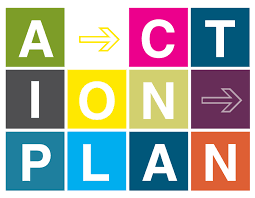
The plan should reflect the specific outcomes, the strategy and process that will be followed to collect evidence and the type of evidence to be collected. The assessment plan therefore serves as an action plan.
Evaluate Coaching Procedures
Click here to view a video that explains how to evaluate your training.
Once the follow-up with the learners has been completed, begin an evaluation of your coaching efforts. A thorough evaluation of your coaching procedures will uncover problems with any of the four steps of the process.
Try to involve your learners in the evaluation, as they may have insights on areas you have not considered. Provide learners with a questionnaire that can be completed easily and returned to you. The questionnaire should be anonymous, so learners will feel free to express their opinions. If most of your coaching is one-on-one, you may want to wait until you have trained several people before sending out a questionnaire, so each trainee does not respond alone. Include questions that address each of the four steps of the coaching process.
In addition to asking for opinions on the questionnaire, you can include a few “test” questions. When you review the responses, keep track of questions that frequently receive wrong answers. Several wrong answers for the same question could indicate that either the question is faulty, or information was not communicated clearly during the coaching. Don’t get hung up on unusually high or low ratings by one or two learners. Focus on the trends to get a true assessment of the coaching.
If you use a follow-up checklist for the learners, you will have a record of the areas that cause problems frequently. Once again, look for trends. Consider the following:
- Are many learners making the same mistakes?
- Are there certain problem areas?
- What things are learners doing well?
- Are learners getting support from their helpers?
The answers to these questions will offer insight into the success of your coaching efforts.
Evaluating Your Performance
After assessing the evaluations, make an objective evaluation of your performance as a coach. This may be hard to do, but it is important. Ask these questions.
- Did I prepare the coaching content properly?
- Did I have the materials needed for the coaching?
- Did I ensure that the coaching environment was conducive to learning?
- Was I open to questions from the learners during each step?
- Was my presentation/demonstration effective?
- Did I take enough time to verify that the learners understood the tasks?
- Did I have the learners practice the tasks during a tryout?
- Did I have a follow-up after the coaching session?
- Do the learners feel confident about performing the tasks?
Answers to these questions will indicate whether you need to make changes in your coaching before the next session. Compare your answers to the learners’ evaluations. Are your answers similar to those of the learners? If not, which questions differ?